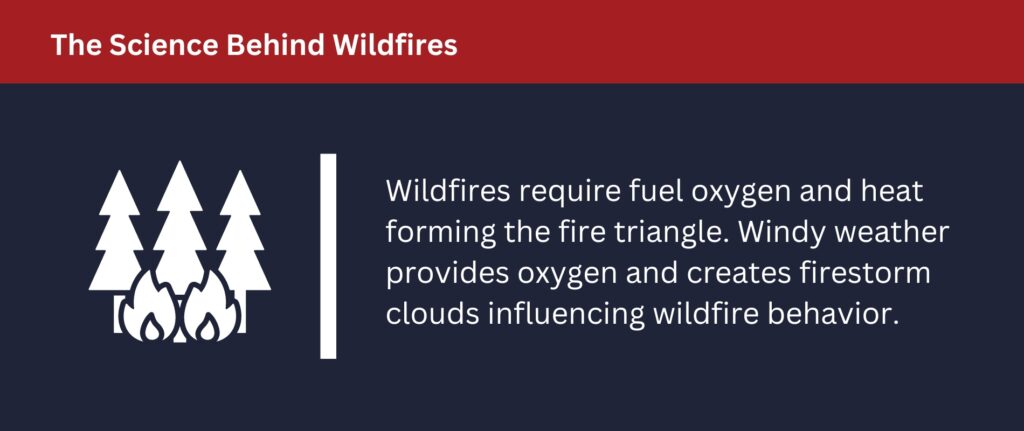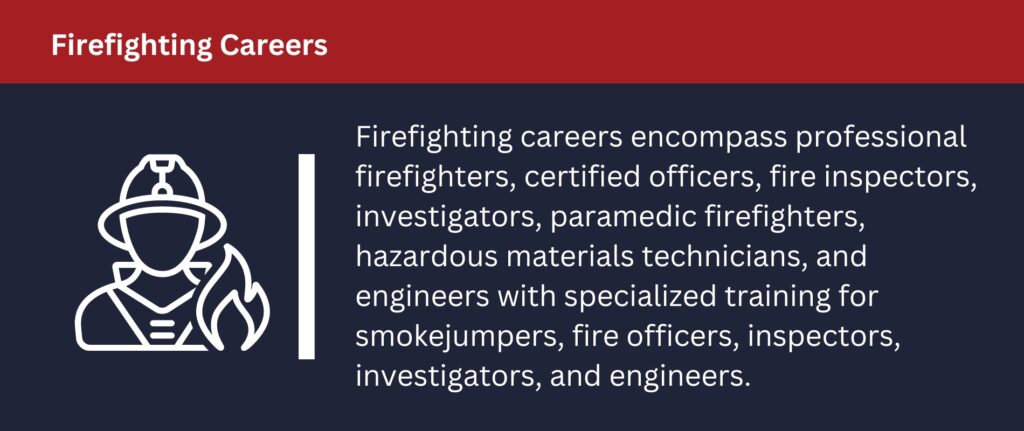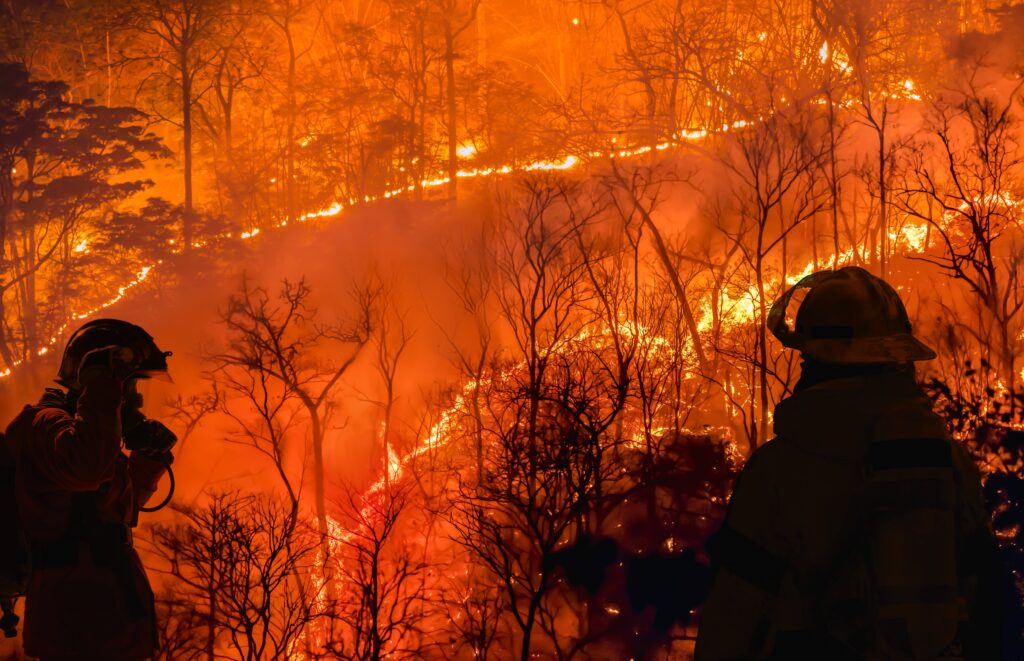Firefighting is one of the noblest and most dangerous professions that a person can pursue. There are few places where that danger is more apparent than in California, where wildfires are almost year-round occurrences. Every year, the state loses millions of acres of land to the devastation of wildfires, due in part to drier than normal winters and extreme heat in the summers. With an ever-growing shortage of firefighters, battling California’s wildfires is increasingly difficult.
What Are Wildfires?
A wildfire is a destructive and unplanned fire in a forest or other natural area. As the name suggests, wildfires are uncontrolled, and they can quickly spread over large swaths of land. The speed with which they spread and their massive sizes are the biggest ways in which they differ from other fires.
The Science Behind Wildfires

Wildfires require three things to exist: fuel, oxygen, and a source of heat. These elements are known as the fire triangle. In a dry, wooded area, dried grasses or other vegetation may serve as fuel. There is always an abundant supply of oxygen in the air, so all that’s needed is heat for a fire to start. This heat may come from human actions or a natural source, such as lightning or even extreme heat from the sun. When humans supply the heat, it’s often by an accidental act, like carelessly discarding a cigarette or leaving a campfire unattended. Once a fire has sparked, its ability to spread depends on its fuel load, which is the amount of flammable material that surrounds the fire source. Wildfires grow so quickly because they often have a lot of fuel sources to feed on. If the fuel is dry, as it is in many parts of California, the fire spread will be harder to control, as it will feed on the fuel much faster. Because wildfires burn so hot, the heat from the flames can actually dry out materials ahead of the fire as it approaches, creating more fuel for the flames.
Weather also plays an important role in how wildfires behave. Windy weather provides wildfires with more oxygen, which helps them to spread farther and even change direction. Extreme wildfires can even create their own weather patterns and produce winds that can carry embers. These conditions can also help to create firestorm clouds that can either produce rain to help combat the fire or cause lightning that ignites more fires.
- The Science of Wildfires
- All About Wildfires: The Science Behind Wildfires
- Wildfire Science
- An Insider’s Perspective on the Science of Fire
- Explainer: How Wildfires Start and Spread
How Do We Fight Wildfires?
The goal when fighting a wildfire is to remove either the heat, the fuel, or the oxygen. By successfully removing an element from the fire triangle, firefighters are able to put out the fire. This is known as fire suppression. One example of suppression is the dropping of fire retardant or water from an aircraft to eliminate heat. Another way firefighters combat wildfires is by clearing away vegetation and trees by using hand tools, such as chainsaws, as a way to eliminate sources of fuel. Suppression also often involves the use of tools to dig or scrape fuel-free boundaries called fire lines that can slow down or stop a fire. Besides water from helicopters and air tankers, hoses and portable pumps may also help fight wildfires if there is a source of water nearby.
- Air Attack: How California Uses Dozens of Aircraft to Battle Wildfires
- Are Wildfires Bad? Fighting Wildfires
- Firefighting Techniques
- Fighting Fire With Tech
- Wildfire Technology: Tackling the Spread of Wilderness Fires With Digital Tech
Climate Change and Wildfires
Scientists have directly associated the increased number of wildfires in California and other places around the world with climate change. Greenhouse gases like carbon dioxide cause climate change, trapping the heat from the sun and making the temperature rise. As a result, places like California experience ever more extreme heat and drought conditions that lead to an increase in wildfires. As wildfires burn, they release more carbon dioxide, thus further contributing to the climate change cycle.
- Climate Change Is Causing More Wildfires, and Governments Are Unprepared, Says U.N.
- Climate Change and Fire in the Western United States
- Here’s How Climate Change Affects Wildfires
- The Climate Change Link to More and Bigger Fires
How to Prepare for Wildfires

During a wildfire, the homes and businesses of people living in the area are at considerable risk. Advance preparation can reduce these risks, which include property loss, injury, or even death. Creating an extended safety zone around the house is a good way to prepare. This zone should be 30 to 100 feet wide and contain little or no flammable vegetation or combustible materials. Homeowners should also regularly trim branches overhanging the house, and lawns should always be cut and well-maintained. Replacing highly flammable plants like Italian cypress or ornamental juniper with fire-resistant alternatives can also help stop a home from being ignited by flying embers.
Manufacturers often build homes with materials that cannot withstand a wildfire. People living in high-risk areas should inspect their homes with this in mind, starting at the roof. Replace flammable shingle or wood roofs with composite or clay tile. The walls of a house may also be a source of concern, as they are commonly made of wood products. The cost of replacing the walls with building materials that are resistant to fire is worth the safety it brings to those who live in fire-prone areas.
People should also be prepared to water down their home and yard if necessary by having more than one water hose that’s long enough to reach the farthest corners of the property. To reduce the risk of embers flying into the home, homeowners should also place wire mesh over vents and use a non-flammable screen to cover the chimney.
- Protecting Your Home From Wildfire: Creating Wildfire-Defensible Zones
- Prepare for a Wildfire
- Prepare for Wildfire: Defensible Space
- How to Prepare for a Wildfire
Stay Safe During a Wildfire
Ultimately, keeping yourself and your family safe from injury is the most important thing. In order to be safe during a wildfire, be prepared with an emergency supply kit. This kit should include items such as blankets, bottled water, and first aid supplies. The kit should also include respirators to help you avoid breathing in smoke particles. If officials have not given an order to evacuate, stay indoors and in a room that has few or no windows. In addition, the room should not have a fireplace that could let smoke in. If possible, an air purifier or cleaner can help reduce any smell of smoke that may enter the room.
If an evacuation order has been given, don’t delay. It’s helpful to have more than one exit route and several places where you can stay until it is safe to return home. Because not all places welcome animals, people with pets should do research in advance to find places that will accept them.
- Stay Safe During a Wildfire
- If You Get Trapped
- How to Prevent Injury and Damage During a Wildfire
Firefighting Careers

There are many firefighting career paths to choose from. The most visible face of firefighting is the professional firefighter. Firefighters fight residential and commercial fires, but they can also get specialized training for other types of operations. Firefighters who fight fires by jumping from planes, for example, are a specially trained group called smokejumpers.
Another career path is to move up the ladder and be certified as a fire officer. Officers strategize, make important decisions, and coordinate rescue efforts. They also help ensure that equipment is being maintained and that firefighters receive proper training. Another career path for experienced firefighters is to become a fire inspector. It is an inspector’s job to check buildings to ensure that they meet fire codes and are safe. A fire investigator is a person who receives training to investigate a fire and determines how it was started. Other firefighter careers include paramedic firefighters, hazardous materials technicians, and engineers who receive training to operate fire trucks.
- How to Advance Your Career in Fire Service
- Understanding the Firefighter Career Path
- Types of Firefighting Jobs


